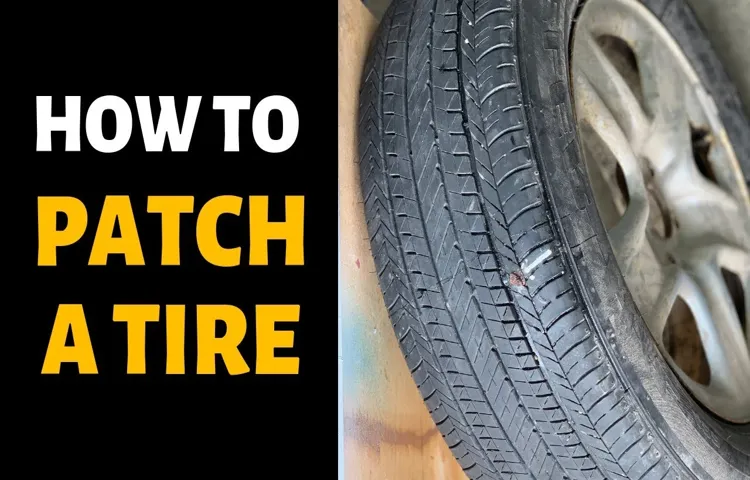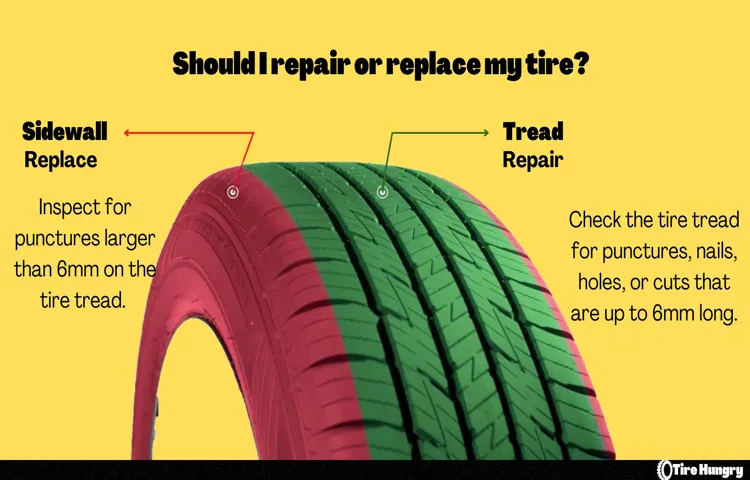If you’re a driver, there’s nothing more frustrating than encountering a flat tire on your journey. It’s an inconvenience that can put a dent in your plans and result in a lot of wasted time. But fear not! The solution to your flat tire problem is tire patching.
Tire patching is a process of fixing punctured or damaged tires, returning them to full working condition. It’s a quick and easy procedure that can save you the cost of having to buy a new tire. In this blog post, we’ll delve into the cost and process of tire patching, so you know what to expect the next time you experience a flat tire.
Table of Contents
Introduction
Have you ever wondered how much it costs to patch up a tire? Well, the answer is not so straightforward. The cost of repairing a tire can vary depending on various factors, including the type of tire, the extent of the damage, and the location of the damage on the tire. A puncture near the center of the tread may be easier to repair compared to a puncture near the sidewall of the tire, which may require the tire to be replaced entirely.
Additionally, the cost of repairing a tire may also depend on the tire’s brand and size. On average, the cost of repairing a tire can range from $10 to $30, but the actual cost can vary depending on these factors. It is essential to know that when it comes to tire maintenance, prevention is always better than cure.
Consider investing in high-quality tires, checking your tire pressure regularly, and avoiding driving on rough terrains to avoid damaging your tires and keeping your repair costs low.
What is tire patching?
Tire patching is a process that involves repairing punctures or damages in a tire’s tread area or sidewall. It is an affordable alternative to replacing the entire tire and can be done quickly and conveniently by a professional tire technician. In many cases, a tire patch can extend the life of a tire, providing a safe and reliable driving experience for many more miles.
This process involves removing the tire from the wheel, inspecting the puncture or damage, and then cleaning and buffing the area. The patch is then applied and cured using special equipment, ensuring a secure fit and a leak-free seal. Tire patching is a cost-effective solution for drivers who want to save money and avoid the hassle of buying a new tire.

Why patching a tire is important?
“Why patching a tire is important?” Driving is a wonderful experience, but it comes with its risks, such as tire punctures. A flat tire can be a hazard and uncomfortable to drive with. This is where tire patching comes in handy.
Tire patching is the process of repairing a punctured tire by sealing the hole on the inside with a rubber patch. Not everyone is familiar with this process, and some may neglect it, leading to unfavorable consequences. Whether it is a small puncture or a large tear, patching a tire is crucial.
It helps protect the tire from further damage and helps maintain its integrity, cost-effectively. The safety of yourself, your passengers, and other road users are compromised when a tire is left unpatched. That’s why it’s important to seek professional help and get your tire patched as soon as possible in any case of puncture.
So, do not underestimate the power of a small rubber patch as it could be the difference between getting stranded in the middle of nowhere and having an enjoyable driving experience.
Factors Affecting Tire Patching Cost
When you need to patch up a tire, the cost can vary depending on a few different factors. The size of the tire, the location of the puncture, and the type of vehicle are all things that can impact the price. Generally, smaller tires will be cheaper to patch than larger ones, and a puncture that is located in the sidewall of the tire may be more difficult to repair and therefore more expensive.
Another consideration is the type of vehicle that you drive, as the larger and heavier the vehicle, the harder it is to repair the tire. Additionally, the quality of the patch itself can also impact the cost. While you may be tempted to go for the cheapest option, it’s important to remember that a poorly done patch can fail quickly, leading to further expenses down the line.
Overall, while it may be frustrating to have to pay to patch up a tire, it’s important to consider the different factors that can impact the cost to ensure the repair is done correctly and cost-effectively in the long run.
Location of puncture
If you’ve ever had a flat tire, you know how frustrating it can be. The cost of repairing a punctured tire depends on various factors, including the location of the damage. If the puncture is in the tread area of the tire, it can typically be patched without much difficulty or expense.
However, if the puncture is in the sidewall or shoulder of the tire, repairing it may not be possible, and the tire will need to be replaced. Factors such as the size and type of the tire, the severity of the damage, and the age of the tire also play a role in determining the cost of repairs. In general, it’s best to get a quote from a professional tire repair service to get an accurate estimate of the cost.
Remember, driving on a damaged tire can be dangerous, so it’s essential to address punctures as soon as possible to ensure your safety on the road.
Type of tire
When it comes to patching a tire, the cost can vary depending on a number of factors. One of the most important factors is the type of tire that needs to be patched. Different types of tires require different methods of patching, which can impact the overall cost.
For example, a patch for a car tire may be less expensive than a patch for a commercial truck tire. This is because truck tires are often larger and harder to work on, which requires more time and expertise. Additionally, the cost of a tire patch can also be affected by the location of the puncture and the severity of the damage.
While a small puncture may be quick and easy to fix, a larger puncture or damage to the tire’s sidewall can result in the need for a more extensive repair or even replacement. Ultimately, the cost of patching a tire will depend on a variety of factors, but choosing an experienced tire technician who can accurately assess the damage and determine the best course of action is key to ensuring a safe and cost-effective repair.
Size of tire
When it comes to patching a tire, there are several factors that can affect the cost. One of these is the size of the tire. Generally, larger tires will cost more to patch than smaller ones.
This is because larger tires require more materials and time to repair. Additionally, the location of the damage on the tire can also impact the cost. If the damage is closer to the center of the tire, it may be easier and less costly to repair.
On the other hand, if the damage is located on the sidewall or near the rim, it may require a more extensive repair or even a replacement. It’s important to have a professional evaluate the damage and provide an estimate for the repair cost based on these factors. Overall, the cost of patching a tire can vary widely depending on a range of factors, so it’s always best to get an expert opinion before making any decisions.
Severity of damage
When it comes to fixing a damaged tire, the severity of the damage is a major factor that affects the cost of patching. A small puncture or nail hole may only require a simple patch or repair, which can cost anywhere from $10 to $30. However, if the damage is more severe, such as large tears or sidewall damage, the cost of repair can increase significantly.
This is because more extensive repairs may require additional equipment, labor, and materials to properly fix the issue. Additionally, if the tire cannot be safely repaired, the cost of replacing the tire entirely will also need to be considered. Therefore, it is important to have a professional assess the damage to determine the best course of action and provide an accurate cost estimate.
Remember, it is always better to prioritize safety over cost when it comes to your tires.
Labor costs
If you are looking to patch a tire, the cost may vary depending on various factors. One of the most significant factors that determine the cost of tire patching is labor costs. Labor costs are affected by several factors, such as experience level, location, and demand for services.
The experience level of the technician will affect how much they charge for their services. Technicians that have been patching tires for years may charge more than those that are new to the industry. Additionally, location plays a significant role in labor costs, with higher costs associated with urban areas than rural areas.
Lastly, the demand for services affects the cost of labor. If there is high demand, technicians may charge more than if there is low demand. Overall, labor costs play a significant factor in determining tire patching costs, so it is crucial to find an experienced technician in a location that provides reasonable prices for their services.
Average Cost of Tire Patching
If you’ve ever suffered a flat tire, you know how frustrating it can be. Fortunately, getting a tire patched up is a relatively affordable fix. On average, the cost to patch a tire can range from $10 to $30, depending on factors such as the location and severity of the puncture.
It’s important to note that if your tire has sustained damage to the sidewall or tread, it may not be able to be repaired and will need to be replaced altogether. It’s also recommended to have a professional inspect your tire before attempting any DIY patching, as improper patching can lead to further damage or even a blowout. In the long run, taking care of your tires through regular maintenance and prompt repairs when needed can ultimately save you money on costly replacements and disastrous accidents on the road.
National average cost
When you need to get a punctured tire repaired, you might be wondering what the average cost of tire patching is. According to national averages, the cost of patching a tire can vary depending on several factors such as the severity of the puncture, the type of tire, the region you are in, and the mechanic you choose. On average, the cost of tire patching ranges from $10 to $30 per tire.
However, if the damage is beyond repair with a simple patch, you may have to replace the tire, which can cost significantly more. It’s important to keep in mind that regular tire maintenance and inspections can help prevent punctures and costly repairs in the long run. So, if you’re ever in need of a tire patch, be sure to shop around to find a reputable and affordable mechanic to get you safely back on the road.
Factors that affect cost at different locations
When it comes to tire patching, the cost can vary greatly depending on where you are located. On average, the cost of a tire patching service can range anywhere from $15 to $4 However, factors such as the type of vehicle you have, the type of tire, and the location of the service can all affect the cost.
For example, if you have a luxury car or a specialized type of tire, you can expect to pay more for patching services. Additionally, if you live in a larger city, the cost may be higher due to the higher cost of living and increased demand for services. Ultimately, it’s important to do your research and compare prices from different providers to ensure you are getting a fair price for the service.
So, before you go to a tire patching service provider, be sure to check for the average cost of services in your location to ensure you are not overpaying.
DIY vs. Professional Tire Patching
Have you ever had a flat tire and wondered if you should patch it up yourself or take it to a professional? The cost of patching up a tire can vary, but it’s important to consider the time and effort it takes to do it yourself versus the convenience and expertise a professional can offer. If you choose to patch it up yourself, the cost will likely be cheaper but you’ll need to purchase tire patches, a tire plug kit, and a tire sealant which could add up. Additionally, it’s important to have the right tools and experience to ensure the patch is done correctly and safely.
On the other hand, taking it to a professional may cost more but they have the expertise and specialized equipment to ensure the job is done right. Plus, most places offer a warranty on the repair. In the end, it comes down to personal preference and the level of confidence you have in your ability to patch it up yourself.
Regardless of which option you choose, it’s important to remember that keeping your tires in good condition is essential for your safety on the road.
Pros and Cons of DIY patching
When it comes to tire patching, there are pros and cons to doing it yourself versus hiring a professional. On the one hand, DIY patching can save you money and time, as you don’t have to wait for an appointment or pay for labor costs. Additionally, if you’re an experienced car owner, you may have the skills and tools needed to properly patch your tire.
On the other hand, DIY patching can be risky and end up costing you more in the long run. If you don’t have the necessary knowledge or tools, you could damage your tire or even cause an accident. Additionally, a professional tire patch can be guaranteed and is typically done with higher-quality materials, ensuring greater safety and longevity.
Ultimately, whether you choose to go the DIY route or hire a professional depends on your level of experience and comfort with the task at hand. Just remember that safety should always be the top priority, and it may be worth the extra cost to ensure proper patching and maintenance of your tire.
Pros and Cons of professional patching
When it comes to tire patching, one question that often arises is whether to do it oneself or let a professional handle it. DIY tire patching may seem like an easier and more cost-effective option initially, but it also has its downsides. For instance, if the patch is not done thoroughly and correctly, it can lead to a blowout on the road, putting the driver and other road users at risk.
Professional tire patching, on the other hand, involves using specialized equipment and personnel who have the necessary skills and experience to handle any type of tire repair or replacement. However, it might come with a higher price tag. Overall, it is always recommended to weigh the pros and cons of both options and choose based on your level of expertise and the extent of the damage to your tire.
But when in doubt, it’s always best to err on the side of caution and invest in professional tire patching services to ensure your safety on the road.
Conclusion
At the end of the day, the cost of patching up a tire is like the price of a good punchline – it all depends on the setup. Whether you’re dealing with a small puncture or a blown-out tire, the process of fixing it will vary in complexity and cost. But one thing’s for sure: investing in quality repairs now can save you from some major tire drama later.
So next time you find yourself wondering “how much is it to patch up a tire?” just remember that the answer is all in the details.”
FAQs
What factors influence the cost of patching up a tire?
The cost of patching up a tire can vary depending on factors such as the type and size of the tire, the severity of the damage, and the price of labor and materials at the tire shop.
Can a tire be patched up multiple times?
In general, a tire can be patched up multiple times as long as the damage is within a certain range and the previous patches are still holding up. However, it’s important to consult with a tire expert to determine whether it’s safe to continue patching up a tire or if it’s time for replacement.
Is it cheaper to patch up a tire than to replace it entirely?
In many cases, patching up a tire can be a more cost-effective solution than replacing it, especially if the damage is minor. However, if the tire is severely damaged or old, it may be more practical to invest in a new tire for safety and longevity.
Can a DIY tire patch kit be used instead of going to a professional tire shop?
While DIY tire patch kits can be a convenient solution for minor tire damage, it’s always recommended to have a professional inspect the tire to ensure proper repair and safety. Additionally, using a DIY kit on a severely damaged tire could be dangerous and lead to further problems down the line.
How long does it typically take to patch up a tire at a tire shop?
The length of time it takes to patch up a tire at a tire shop can vary depending on factors such as the workload of the shop and the severity of the damage. However, most tire repairs can be completed within 30 minutes to an hour.
Are there any precautions that should be taken after patching up a tire?
After patching up a tire, it’s important to avoid driving on rough terrain or at high speeds for the first 24 to 48 hours to allow the patch to properly set. Additionally, it’s recommended to have the tire inspected regularly to ensure the patch is holding up.
Can all types of tire damage be patched up, or are there some instances where replacement is necessary?
While many types of tire damage can be patched up, there are instances where replacement is necessary for safety reasons. For example, if the tire has a large puncture or is severely worn down, it may be more practical to replace the tire rather than patch it up.



